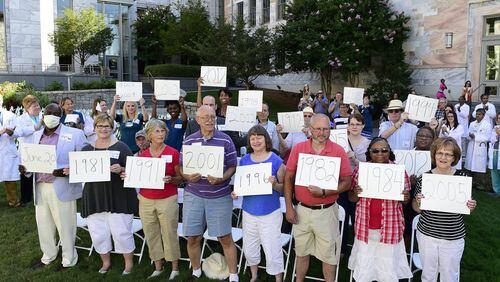Glenn Pontoo holds a sign that simply says “June 20.”
On Monday, the Augusta high school teacher became the 5,000th person to receive a transplant through Emory University's Winship Cancer Institute's Bone Marrow and Stem Cell Transplant Center.
A day later, he joined more than a dozen other recipients and their families, nurses and doctors to celebrate the milestone.
Five thousand small white flags, each one symbolizing a patient who has received a transplant, dotted the lawn of the Emory School of Medicine.
“I feel good,” said Pontoo, 52, who was diagnosed with multiple myeloma (a type of cancer) and will be hospitalized another two weeks. “I’m just trying to stay positive and prayed up.”
It was a reunion, of sorts.
Patients met other patients. Some reunited with doctors and nurses they hadn’t seen in years.
The Winship program, which started in 1979, is the oldest and largest in Georgia.
“It’s a landmark that I think people can identify with,” said Dr. Amelia Langston, medical director of the Bone Marrow and Stem Cell Transplant Center. “It represents the advancement of technology, greater safety and the expansion of the donor pool.”
Today, the transplant experience is easier for patients and outcomes have improved, in part, because of improvements in anti-rejection drugs, reduced chemotherapy conditioning, better medications for treating nausea and better methods for collecting stem cells.
Charity Turner Trimier, 49, of Powder Springs received a bone marrow transplant from her brother, Dexter, when she was 17 years old after being diagnosed with aplastic anemia, a blood disorder that she said may have been caused by lupus.
She said her blood count was so low that doctors told her it was as if she didn’t have any blood. They didn’t think she would live long without the transplant.
“This will let people see the success of transplantation and the need for donors,” said Turner Trimier, a substitute teacher. “Today, you had over 30 years of extended life.”
Tamara Mobley, 40, received a transplant in February 2010, to treat multiple myeloma. Looking around at other recipients made her realize “how far we’ve come.”
About the Author







